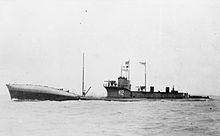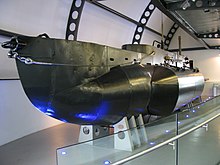Lista okrętów podwodnych Royal Navy
| Nazwy okrętów Royal Navy |
A - B - C - D - E - F - G |
| lotniskowce |
| okręty desantowe |
| krążowniki liniowe |
| pancerniki |
| korwety i slupy |
| krążowniki |
| typy niszczycieli |
| typy fregat |
| okręty wojny minowej |
| monitory |
| okręty patrolowe |
| Królewskie Jachty |
| okręty podwodne |
| okręty wsparcia |
| okręty badawcze |
| bazy floty |
| placówki |
| szpitale i okręty szpitalne |
| bazy lotnicze |
| skrzydła lotnicze |
| główne punkty dowodzenia |
| dywizjony i flotylle |
To jest lista okrętów podwodnych Zjednoczonego Królestwa, podana chronologicznie według typów. Daty oznaczają okres budowy danego typu.
Benzynowo-elektryczne
- typ Holland – 5 okrętów, 1901-1902
- Holland 1 • Holland 2 • Holland 3 • Holland 4 • Holland 5
- typ A – 13 okrętów, 1902-1905
- typ B – 11 okrętów, 1904-1906
- B1 • B2 • B3 • B4 • B5 • B6 • B7 • B8 • B9 • B10 • B11
- typ C – 38 okrętów, 1906-1910
Diesel-elektryczne
- typ D – 8 okrętów, 1908-1912
- typ E – 58 okrętów, 1912-1916
- E1 • E2 • E3 • E4 • E5 • E6 • E7 • E8 • E9 • E10 • E11 • E12 • E13 • E14 • E15 • E16 • E17 • E18 • E19 • E20 • E21 • E22 • E23 • E24 • E25 • E26 • E27 • E29 • E30 • E31 • E32 • E33 • E34 • E35 • E36 • E37 • E38 • E39 • E40 • E41 • E42 • E43 • E44 • E45 • E46 • E47 • E48 • E49 • E50 • E51 • E52 • E53 • E54 • E55 • E56
- typ F – 3 okręty, 1913-1917
- F1 • F2 • F3
- typ S – 3 okręty, 1914-1915
- S1 • S2 • S3
- typ V – 4 okręty, 1914-1915
- V1 • V2 • V3 • V4
- typ W – 4 okręty, 1914-1915
- W1 • W2 • W3 • W4
- typ G – 14 okrętów, 1915-1917
- G1 • G2 • G3 • G4 • G5 • G6 • G7 • G8 • G9 • G10 • G11 • G12 • G13 • G14
- typ H – 44 okręty, 1915-1919
- typ J – 7 okrętów, 1915-1917
- typ M – 4 okręty, 1917-1918
- „Nautilus” – 1 okręt, 1917
- typ L – 34 okręty, 1917-1919
- L1 • L2 • L3 • L4 • L5 • L6 • L7 • L8 • L9 • L10 • L11 • L12 • L14 • L15 • L16 • L17 • L18 • L19 • L20 • L21 • L22 • L23 • L24 • L25 • L26 • L27 • L33 • L52 • L53 • L54 • L55 • L56 • L69 • L71
- typ R – 12 okrętów, 1918
- R1 • R2 • R3 • R4 • R5 • R6 • R7 • R8 • R9 • R10 • R11 • R12
- X1 – 1 okręt, 1921
- typ Odin – 9 okrętów (podtypy Oberon 1, Oxley 2, Odin 6), 1926-1929
- „Oberon” • „Otway” • „Oxley” • „Odin” • „Olympus” • „Orpheus” • „Osiris” • „Oswald” • „Otus”
- typ Parthian – 6 okrętów, 1929
- „Pandora” • „Parthian” • „Perseus” • „Phoenix” • „Poseidon” • „Proteus”
- typ Rainbow – 4 okręty, 1930
- „Rainbow” • „Regent” • „Regulus” • „Rover”
- typ S – 62 okręty (podtypy Swordfish 4, Shark 8, Seraph 33, Subtle 17), 1931-1945
- „Seahorse” • „Starfish” • „Sturgeon” • „Swordfish” • „Salmon” • „Sealion” • „Seawolf” • „Shark” • „Snapper” • „Spearfish” • „Sterlet” • „Sunfish” • P222 • „Safari” • „Saga” • „Sahib” • „Sanguine” • „Saracen” • „Satyr” • „Sceptre” • „Scorcher” • „Scotsman” • „Scythian” • „Sea Devil” • „Seadog” • „Sea Nymph” • „Sea Rover” • „Sea Scout” • „Selene” • „Seneschal” • „Sentinel” • „Seraph” • „Shakespeare” • „Shalimar” • „Sibyl” • „Sickle” • „Sidon” • „Simoom” • „Sirdar” • „Sleuth” • „Solent” • „Spark” • „Spearhead” • „Spirit” • „Spiteful” • „Splendid” • „Sportsman” • „Springer” • „Spur” • „Statesman” • „Stoic” • „Stonehenge” • „Storm” • „Stratagem” • „Strongbow” • „Stubborn” • „Sturdy” • „Stygian” • „Subtle” • „Supreme” • „Surf” • „Syrtis”
- typ Thames – 3 okręty, 1932
- „Clyde” • „Severn” • „Thames”
- typ Grampus – 5 okrętów, 1935-1938
- „Cachalot” • „Grampus” • „Narwhal” • „Porpoise” • „Rorqual” • „Seal”
- typ T – 52 okręty (podtypy Triton 15, Tempest 15, Taciturn 22), 1937-1945
- „Taku” • „Talisman” • „Tarpon” • „Tetrarch” • „Thetis”/„Thunderbolt” • „Thistle” • „Tigris” • „Torbay” • „Triad” • „Tribune” • „Trident” • „Triton” • „Triumph” • „Truant” • „Tuna” • „Tempest” • „Thorn” • „Thrasher” • „Traveller” • „Trooper” • „Trusty” • „Turbulent” • P311 • „Tabard” • „Taciturn” • „Tactician” • „Talent” (P322) • „Talent” (P337) • „Tally-Ho” • „Tantalus” • „Tantivy” • „Tapir” • „Tarn” • „Taurus” • „Telemachus” • „Templar” • „Teredo” • „Terrapin” • „Thermopylae” • „Thorough” • „Thule” • „Tiptoe” • „Tireless” • „Token” • „Totem” • „Tradewind” • „Trenchant” • „Trespasser” • „Truculent” • „Trump” • „Truncheon” • „Tudor” • „Turpin” • „Thor” • „Tiara” • „Theban” • „Threat” • „Talent” (P343)
- typ U – 49 okrętów, 1937-1943
- „Undine” • „Unity” • „Ursula” • „Umpire” • „Una” • „Unbeaten” • „Undaunted” • „Union” • „Unique” • „Upholder” • „Upright” • „Urchin” • „Urge” • „Usk” • „Utmost” • „Uproar” • P32 • P33 • „Ultimatum” • „Umbra” • P36 • „Unbending” • P38 • P39 • P41 • „Unbroken” • „Unison” • „United” • „Unrivalled” • „Unruffled” • P47 • P48 • „Unruly” • „Unseen” • P52 • „Ultor” • „Unshaken” • „Unsparing” • „Usurper” • „Universal” • „Untamed” • „Untiring” • „Varangian” • „Uther” • „Unswerving” • „Vandal” • „Upstart” • „Varne” • „Vox”
- typ P611 – 4 okręty, 1940
- P611 • P612 • P613 • P614
- typ V – 22 okręty, 1943-1944
- „Venturer” • „Viking” • „Veldt” • „Vampire” • „Vox” • „Vigorous” • „Virtue” • „Visigoth” • „Vivid” • „Voracious” • „Vulpine” • „Varne” • „Upshot” • „Urtica” • „Vineyard” • „Variance” • „Vengeful” • „Vortex” • „Virulent” • „Volatile” • „Vagabond” • „Votary”
- typ Amphion – 16 okrętów, 1945-1947
- „Acheron” • „Aeneas” • „Affray” • „Alaric” • „Alcide” • „Alderney” • „Alliance” • „Ambush” • „Amphion” • „Anchorite” • „Andrew” • „Artemis” • „Artful” • „Astute” • „Auriga” • „Aurochs”
- typ Explorer – 2 okręty, 1954-1955
- „Excalibur” • „Explorer”
- typ Porpoise – 8 okrętów, 1956-1959
- „Cachalot” • „Finwhale” • „Grampus” • „Narwhal” • „Porpoise” • „Rorqual” • „Sealion” • „Walrus”
- typ Oberon – 13 okrętów, 1959-1966
- „Oberon” • „Ocelot” • „Odin” • „Olympus” • „Onslaught” • „Onyx” • „Opportune” • „Opossum” • „Oracle” • „Orpheus” • „Osiris” • „Otter” • „Otus”
- typ Upholder – 4 okręty, 1990-1994
- „Unicorn” • „Unseen” • „Upholder” • „Ursula”
Parowo-elektryczne
- „Swordfish” – 1 okręt, 1916-1922
- typ K – 22 okręty, 1916-1919
- K1 • K2 • K3 • K4 • K5 • K6 • K7 • K8 • K9 • K10 • K11 • K12 • K13 • K14 • K15 • K16 • K17 • K26
Miniaturowe okręty
- typ Welman – ponad 100 jednostek
- typ X – 20 okrętów, 1942-43
- X3 • X4 • X5 • X6 • X7 • X8 • X9 • X10 • X20 • X21 • X22 • X23 • X24 • X25 • XT1 • XT2 • XT3 • XT4 • XT5 • XT6
- typ XE – 12 okrętów, 1944
- XE1 • XE2 • XE3 • XE4 „Exciter” • XE5 • XE6 • XE7 • XE8 „Expunger” • XE9 • XE10 • XE11 • XE12
- typ Stickleback – 4 okręty, 1954-1955
- X51 Stickleback • X52 Shrimp • X53 Sprat • X54 Minnow
Okręty o napędzie nuklearnym
Okręty Floty
- „Dreadnought” – 1 okręt, 1960
- typ Valiant – 2 okręty, 1963-1965
- „Valiant” • „Warspite”
- typ Churchill – 3 okręty, 1968-1970
- „Churchill” • „Conqueror” • „Courageous”
- typ Swiftsure – 6 okrętów, 1971-1979
- „Swiftsure” • „Sovereign” • „Superb” • „Sceptre” • „Spartan” • „Splendid”
- typ Trafalgar – 7 okrętów, 1981-1991
- „Trafalgar” • „Turbulent” • „Tireless” • „Torbay” • „Trenchant” • „Talent” • „Triumph”
- typ Astute – 7 okrętów (plan), 2010 – obecnie
Okręty z pociskami balistycznymi
- typ Resolution – 4 okręty, 1964-1969
- „Renown” • „Repulse” • „Resolution” • „Revenge”
- typ Vanguard – 4 okręty, 1986-1999
- „Vanguard” • „Victorious” • „Vigilant” • „Vengeance”
Zobacz też
Bibliografia
- J.J. Colledge, Ben Warlow: Ships of the Royal Navy: The Complete Record of all Fighting Ships of the Royal Navy. London: Chatham Publishing, 2006. ISBN 978-1-86176-281-8. (ang.)
- Robert Gardiner, Roger Chesneau: Conway’s All the World’s Fighting Ships 1922–1946. London: Conway Maritime Press, 1980. ISBN 0-85177-146-7. (ang.)
- Robert Gardiner, Stephen Chumbley: Conway’s All The World’s Fighting Ships 1947-1995. Annapolis: Naval Institute Press, 1996. ISBN 1-55750-132-7. (ang.)
- Robert Gardiner, Randal Gray: Conway’s All the World’s Fighting Ships 1906–1921. London: Conway Maritime Press, 1985. ISBN 0-85177-245-5. (ang.)
- Jan Gozdawa-Gołębiowski, Tadeusz Wywerka Prekurat: Pierwsza wojna światowa na morzu. Warszawa: Lampart, 1994. ISBN 83-902554-2-1.
- Paul E. Fontenoy: Submarines: An Illustrated History of Their Impact (Weapons and Warfare). ABC-CLIO, 2007. ISBN 1-8510-9563-2. (ang.)
- Jerzy Lipiński: Druga wojna światowa na morzu. Warszawa: Wydawnictwo Lampart, 1995. ISBN 83-902554-7-2.
Media użyte na tej stronie
Autor: POA(Phot) Tam McDonald, Licencja: OGL v1.0
Image of HMS Vengeance returning to HMNB Clyde, after completing Operational Sea Training. The trials were conducted in Scottish exercise areas.
HMS Vengeance is the fourth and final Vanguard-class submarine of the Royal Navy. Vengeance carries the Trident ballistic missile, the UK's nuclear deterrent.
- Organization: Royal Navy
- Object Name: HMS Vengeance
- Category: MOD
- Supplemental Categories: Equipment, Submarines, Ballistic
- Keywords: V Boat, HMNB Clyde, HMS Vengeance, Equipment, Ship, Submarine, Ballistic, strategic nuclear deterrent force, SSBN, Vanguard Class, Trident
- Country: Scotland
The first nuclear-powered Royal Navy submarine HMS Dreadnought (S101) after launching, 21 October 1960.
Autor: Rémi Kaupp, Licencja: CC-BY-SA-3.0
Holland no1 submarine, the first british submarine. Model by Vickers-Armstrong.
Autor: Geni, Licencja: CC BY-SA 4.0
A photo of the only preserved x craft X24
















